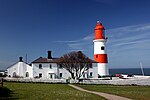The Boldons

The Boldons are a group of three small villages in the north east of England – East Boldon, West Boldon and Boldon Colliery – north of Sunderland, east of Newcastle and south of South Shields and Jarrow. In 2001 they had a population of 13,271.Lying within the historic boundaries of County Durham, the villages are first recorded in print in 1170. Their names evolved from the words "Bold" or "Botl", meaning a building, and "dun", meaning a type of hillfort.In 1866, work began sinking a pit that began producing coal in 1869, and was then known as Boldon New Winning. The village that developed nearby in the 1870s became known as Boldon Colliery. When the mine was deepened and extended in the 1910s, further housing to accommodate the workforce was built to the south of the pit in an area known as Boldon New Town. Until 1974 the area was administered as an urban district of County Durham, but since then has been part of the borough of South Tyneside. In 1976, the Boldon Colliery Band appeared in episode 13 of the television series When the Boat Comes In. The mine closed in 1982 but more jobs became available when an Asda supermarket opened in 1987. Recent developments include Boldon Business Park. Boldon Colliery also has its own multi-screen cinema operated by Cineworld. The main secondary school in the area is Boldon School, a specialist sports college.
Excerpt from the Wikipedia article The Boldons (License: CC BY-SA 3.0, Authors, Images).The Boldons
Lyndon Drive, South Tyneside Boldon Colliery
Geographical coordinates (GPS) Address Nearby Places Show on map
Geographical coordinates (GPS)
| Latitude | Longitude |
|---|---|
| N 54.945 ° | E -1.441 ° |
Address
Lyndon Drive
Lyndon Drive
NE36 0NU South Tyneside, Boldon Colliery
England, United Kingdom
Open on Google Maps




